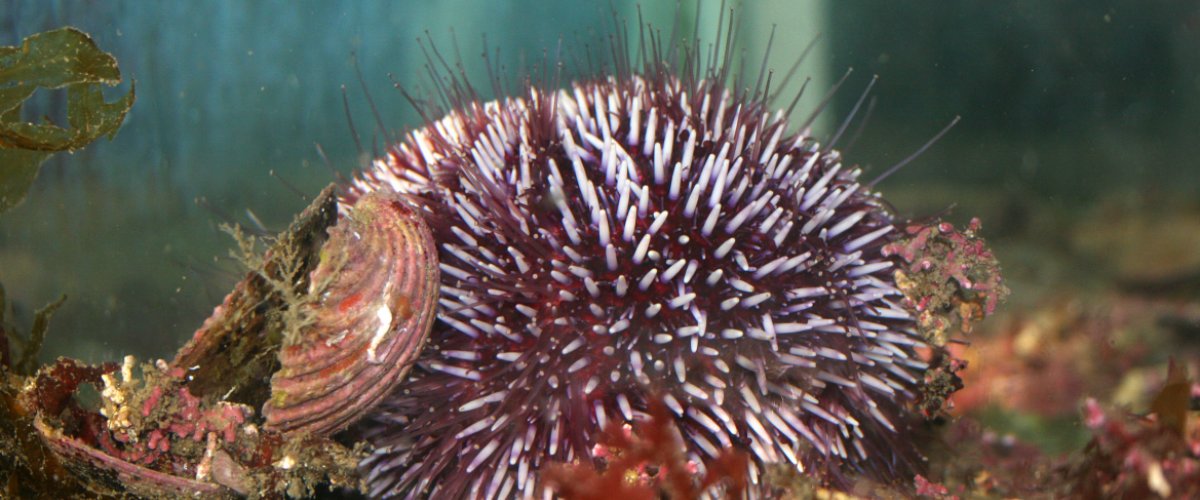


Research
PIs : Julia Morales (DR CNRS, morales@sb-roscoff.fr); Patrick Cormier (PR SU, cormier@sb-roscoff.fr); Fernando Roch (CR CNRS, roch@sb-roscoff.fr)
mRNA translation is a key step in the regulation of gene expression, allowing rapid and precise adjustment of the cell to physiological and pathological variations. We are interested in the molecular and cellular mechanisms that link translational control to cell cycle regulation and early embryonic development of sea urchins.
The early development of sea urchin embryos is an interesting and relevant model for the study of translational control. Fertilization triggers a rapid increase in protein synthesis, necessary for the first mitotic division of the embryo. This increase in protein synthesis activity is independent of any new transcription and relies on maternal mRNA recruitment. Gametes are easy to obtain in large quantities, allowing for molecular, biochemical and cellular approaches.
We have identified several translation initiation and elongation factors (eIF4E, 4E-BP, eIF2, eEF2) activated and involved in the protein synthesis increaser at fertilization. We demonstrated the important role of the availability of eIF4E factor and the mTOR pathway in the translation of cyclin B, a key regulator of cell cycle progression. By a polysome profiling approach developed in the team, we showed that only a small subset of maternal mRNAs are translated after fertilization, targeting proteins involved in regulatory pathways such as cell cycle regulation or lysosome biogenesis. We develop functional approaches that allow us to study the regulation and impact of specific mRNA translation on mitotic cell cycles and early embryonic cellular processes in sea urchins.
People involved : Sandrine Boulben, IE CNRS; Sonia Dufour, PhD Sorbonne Université SU; Anne-Catherine Dock-Bregeon – DR CNRS Emérite
Former members : Florian Pontheaux (PhD SU 2018-2022); Harold Moundoyi (PhD SU/Region Bretagne 2015-2020); Héloïse Chassé (PhD SU/Région Bretagne 2012-2015); Omid Feizbakhsh (ATER SU 2018-2019); François Sement (Post-Doc SAD Région Bretagne 2018-2019); Odile Mulner-Lorillon (DR CNRS, retired); Robert Bellé (PR SU Emeritus)
Publications :
- Pontheaux, F., Boulben, S., Chassé, H., Boutet, A., Roch, F., Morales, J. and Cormier, P (2022). eIF4B mRNA Translation Contributes to Cleavage Dynamics in Early Sea Urchin Embryos. Biology 11(10): 1408. DOI: 10.3390/biology11101408.
- Pontheaux F, Roch F, Morales J, Cormier P (2021) Echinoderms: Focus on the sea urchin model in cellular and developmental biology. In: Boutet, A. and Schierwater B., eds. Handbook of Established and Emerging Marine Model Organisms in Experimental Biology, CRC Press. https://doi.org/10.1201/9781003217503
- Feizbakhsh, O., Pontheaux, F., Glippa, V., Morales, J., Ruchaud, S., Cormier, P. and Roch, F (2020). A Peak of H3T3 Phosphorylation Occurs in Synchrony with Mitosis in Sea Urchin Early Embryos. Cells 9(4): 898. DOI: 10.3390/cells9040898.
- Chassé, H., Boulben, S., Cormier, P. and Morales, J (2019). Translational Control of Canonical and Non-Canonical Translation Initiation Factors at the Sea Urchin Egg to Embryo Transition. International Journal of Molecular Sciences 20(3): 626. DOI: 10.3390/ijms20030626.
- Chassé, H., Aubert, J., Boulben, S., Le Corguillé, G., Corre, E., Cormier, P. and Morales, J (2018). Translatome analysis at the egg-to-embryo transition in sea urchin. Nucleic Acids Research 46(9): 4607-4621. DOI: 10.1093/nar/gky258.
- Chassé, H., Boulben, S., Costache, V., Cormier, P. and Morales, J (2017). Analysis of translation using polysome profiling. Nucleic Acids Research: gkw907. DOI: 10.1093/nar/gkw907.
Project leader: Sandrine Ruchaud – DR CNRS (sandrine.ruchaud@sb-roscoff.fr)
Our general interest lies in analyzing the molecular mechanisms that orchestrate the smooth progression of cell division. Chromosome bi-orientation, segregation into the two future daughter cells and cytokinesis are essential steps in ensuring the fidelity of the process, and must be finely regulated. Their coordination is tightly controlled by protein kinases whose expression/activity is deregulated in many cancers. Errors in these steps can also lead to aneuploidy, predisposing cells to cancerous transformation.
For several years now, we have been studying the biological functions and inter-regulation of some of these protein kinases (notably Aurora B and Haspin), in order to gain a better understanding of their mechanisms of action and use this knowledge to design new targeted anti-cancer therapies (marine origin, bio-inspired and/or synthetic) in collaboration with several medicinal chemistry teams.
We address these biological questions through two complementary and synergistic approaches, (i) reverse genetics (gene invalidation/complementation, knockout/knockin by CRISPR/Cas9), high-resolution microscopy and biochemistry, and (ii) chemobiology through the development of series of compounds inhibiting or degrading (PROTAC) the studied kinases, which directs our projects towards a translational level while providing original tools to help us answer our biological questions.
People involved: Béatrice Josselin – IE CNRS; Pierre Brindeau – PhD CNRS
Former members: Omid Feizbakhsh (PhD and Post-Doc 2013-2018)
Publications:
- Wael Zeinyeh, Yannick J. Esvan, Béatrice Josselin, Mathilde Defois, Blandine Baratte, Stefan Knappǁ, Apirat Chaikuadǁ, Fabrice Anizon, Francis Giraud, Sandrine Ruchaud, Pascale Moreau. (2022) Synthesis and biological evaluation of Haspin inhibitors: kinase inhibitory potency and cellular activity. Eur. J. Med. Chem.
- Sreenivas Avula, Lang Xingfen, Peng Xudang, Micky Tortorella, Béatrice Josselin, Stéphane Bach, Stephane Bourg, Pascal Bonnet, Frédéric Buron, Sandrine Ruchaud, Sylvain Routier and Cleopatra Neagoie. (2022) Design and biological evaluation of substituted 5,7-dihydro-6H-indolo[2,3-c]quinolin-6-one as novel selective Haspin inhibitor. Journal of Enzyme Inhibition and Medicinal Chemistry.
- Charlotte Juillet, Ludmila Ermolenko, Dina Boyarskaya, Blandine Baratte, Béatrice Josselin, Hristo Nedev, Stéphane Bach, Bogdan I. Iorga, Jérôme Bignon, Sandrine Ruchaud and Ali Al-Mourabit. (2021) Simplified Marine Metabolite Analogs: First non-ATP Competitive Aurora B Kinase Inhibitors. J. Med. Chem.
- Jonathan Elie, Omid Feizbakhsh, Nathalie Desban, Béatrice Josselin, Blandine Baratte, Amandine Bescond, Julien Duez, Xavier Fant, Stéphane Bach, Dominique Marie, Matthieu Place, Sami Ben Salah, Agnes Chartier, Sabine Berteina-Raboin, Apirat Chaikuad, Stefan Knapp, Fabrice Carles, Pascal Bonnet, Frédéric Buron, Sylvain Routier and Sandrine Ruchaud. (2020) Design of new disubstituted imidazo[1,2-b]pyridazine derivatives as selective Haspin inhibitors. Synthesis, binding mode and anticancer biological evaluation. Journal of Enzyme Inhibition and Medicinal Chemistry.
- Omid Feizbakhsh, Florian Pontheaux, Virginie Glippa, Julia Morales, Sandrine Ruchaud, Patrick Cormier and Fernando Roch. (2020) A Peak of H3T3 Phosphorylation Occurs in Synchrony with Mitosis in Sea Urchin Early Embryos. Cells.
- Diana Papini, Xavier Fant, Hiromi Ogawa, Nathalie Desban, Kumiko Samejima, Omid Feizbakhsh, Bilge Askin, Tony Ly, William C. Earnshaw and Sandrine Ruchaud. (2019) Cell cycle-independent furrowing triggered by phosphomimetic mutations of the INCENP STD motif requires Plk1. Journal of Cell Science.
- Sofia-Eléna Motuhi, Omid Feizbakhsh, Béatrice Foll-Josselin, Blandine Baratte, Claire Delehouzé, Arnaud Cousseau, Xavier Fant, Jeannette Chloë Bulinski, Claude Elisabeth Payri, Sandrine Ruchaud, Mohamed Mehiri and Stéphane Bach. (2019) Neurymenolide A, a Novel Mitotic Spindle Poison from the New Caledonian Rhodophyta Phacelocarpus neurymenioides. Marine Drugs.
Project leader: Pierre Colas – CR INSERM (colas@sb-roscoff.fr)
CDK10 has long remained one of the most mysterious CDKs (cyclin-dependent kinases), in the absence of a known activating cyclin. We identified an activating cyclin (CycM, recently renamed Q), revealed the kinase activity of CDK10/CycQ, unveiled its role in the control of ETS2 stability and in ciliogenesis. We established the first etiological basis of STAR syndrome caused by CycQ mutations, and we contributed to the description of a new syndrome (Al Kaissi) caused by CDK10 mutations. In addition, we have developed a screening assay and identified the first molecules inhibiting CDK10/CycQ kinase activity.
We continue the study of the functions of CDK10 / CycQ mainly according to 4 approaches: i) Identification of interaction partners of CDK10 and CycQ; ii) Functional characterization of CDK10 and CycQ variants involved in Al Kaissi and STAR syndromes; iii) Biological chemistry approach, aiming to selectively inhibit CDK10 by small chemical molecules (iv) Knockout of the CDK10 gene by CRISPR in immortalized human cells.
People involved: Sabine Genicot – IR CNRS; Thomas Robert – IE CNRS; Anne-Catherine Dock-Bregeon – DR CNRS Emérite
Former members: Vincent Guen (Master and PhD 2010-2013); Amel Hamdi (PhD and Post-Doc 2009-2013); Carly Gamble (Post-Doc 2011-2014)
Publications:
- Robert T, Dock-Bregeon AC, Colas P. (2021) “Functional characterization of CDK10 and cyclin M truncated variants causing severe developmental disorders” Mol Genet Genomic Med.
- Colas P. (2020) “Cyclin-dependent kinases and rare developmental disorders”. Orphanet J Rare Dis
- Robert T, Johnson JL, Guichaoua R, Yaron TM, Bach S, Cantley LC, Colas P. (2020) “Development of a CDK10/CycM in vitro kinase screening assay and identification of first small-molecule inhibitors”. Front Chem.
- Guen VJ, Edvardson S, Fraenkel ND, Fattal-Valevski A, Jalas C, Anteby I, Shaag A, Dor T, Gillis D, Kerem E, Lees JA, Colas P, Elpeleg O. (2018) “ A homozygous deleterious CDK10 mutation in a patient with agenesis of corpus callosum, retinopathy, and deafness.” Am J Med Genet.
- Guen VJ, Gamble C, Lees JA, Colas P. (2017) “The awakening of the CDK10/Cyclin M protein kinase” Oncotarget
- Guen VJ, Gamble C, Perez DE, Bourassa S, Zappel H, Gärtner J, Lees JA, Colas P. (2016) “STAR syndrome-associated CDK10/Cyclin M regulates actin network architecture and ciliogenesis.” Cell Cycle.
- Guen V, Gamble C, Flajolet M, Unger S, Thollet A, Ferandin Y, Superti-Furga A, Cohen PA, Meijer L, Colas P. (2013) “CDK10/cyclin M is a protein kinase that controls ETS2 degradation and is deficient in STAR syndrome”. Proc Natl Acad Sci USA.
Project leader: Agnès Boutet (agnes.boutet@sb-roscoff.fr)
We are interested in understanding the physiological and molecular mechanism associated to the maintenance of the elasmobranch nephron progenitors of elasmobranch, a subclass of Chondrichthyes or cartilaginous fish, at the post-embryonic stage.
Nephrons are the functional units of the kidney. During embryogenesis they are derived from a pool of self-renewing progenitors that cease propagation and are terminally differentiated within few days after birth in mammals. Each kidney is made of thousands or millions of nephrons. In mammals, the number of nephrons is fixed at birth meaning that the depletion of the progenitor pool is a physiological process and that adult mammals cannot generate new nephrons. In contrast, new nephrons are continually added to the adult kidney of elasmobranchs and this process contributes to the lifelong kidney growth in this taxon. Neonephrogenesis is also observed upon partial nephrectomy in the little skate indicating that the aptitude to growth new nephrons can be triggered in a pathological context. This interesting regenerative property of the elasmobranch kidney relies on the maintenance of the nephron progenitor pool beyond hatching. In particular, we are studying the role of global protein synthesis control in this maintenance together with the one of the mTOR pathway, an important signalisation pathway involved in translation initiation.
Our model is the small-spotted catshark (Scyliorhinus canicula), an abundant shark of the Northeast Atlantic. Embryos at different developmental stages, juveniles and adults (see pictures below) are available at the Station Biologique de Roscoff through the EMBRC France portal.
People involved: Julia Morales DR2; Virgine Glippa AI
Former members: Yasmine Lund-Ricard (PhD 2019-2023); Julien Calloch (Engineer 2017-2018)
Publications:
- Lund-Ricard Y, Cormier P, Morales J, and Boutet A. mTOR Signaling at the Crossroad between Metazoan Regeneration and Human Diseases. Int J Mol Sci. 2020
- Lund-Ricard Y and Boutet A. Current trends in Chondrichthyes experimental biology (2021) In: Boutet, A. & B. Schierwater, eds. Handbook of Established and Emerging Marine Model Organisms in Experimental Biology, CRC Press.